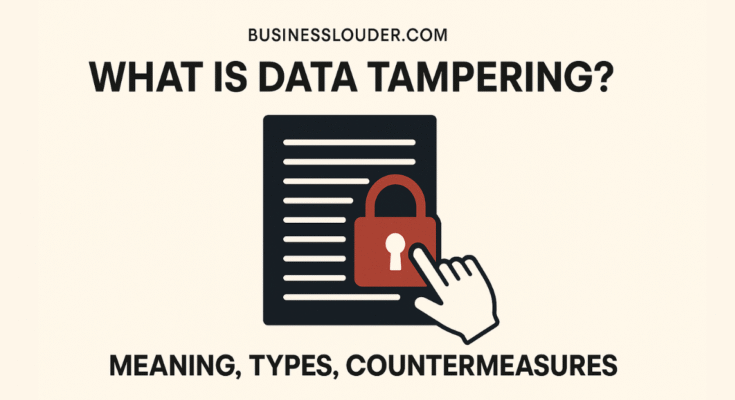The phrase “data tampering” looms large as a terrifying menace that can devastate enterprises, organizations, and individuals alike in the constantly changing field of data protection.
In this extensive guide, we explore what is data tampering to provide readers with a grasp of what does data tampering means, the several types it encompasses, the risks it poses, and the effective preventive actions that are required to protect sensitive data.
By the time you finish reading this article, you’ll not only be knowledgeable about data tampering but also have the tools you need to strengthen your defenses against this sneaky threat.
What Does Tampering Mean?
Data tampering is fundamentally the intentional, unauthorized, and frequently malicious manipulation of data to mislead, harm, or gaining an unfair advantage.
It entails the alteration, distortion, or corruption of data in a way that causes it to cease correctly representing reality.
Data tampering can occur at any point in the data lifecycle, including when the data is being collected, stored, transmitted, or even presented to end users.
What is Data Tampering?
Data tampering, also known as data manipulation or data alteration, is a broad phrase that refers to a variety of illegal actions meant to jeopardize the integrity and dependability of data.
It is critical to comprehend the complexities of these activities since they frequently take advantage of weaknesses in data systems and processes.
Types of Data Tampering
1. Data Falsification
Falsifying data entails creating new data or changing already-existing data to create a false narrative. This kind of manipulation is used by perpetrators to bolster false claims, cover up illegal activity, or influence decision-making.
Imagine a situation where a dishonest worker at a pharmaceutical business falsifies information in a clinical trial report to overstate the efficacy of a novel medication.
Regulation-related problems, threats to the public’s health, and serious legal repercussions could result from this fabrication.
2. Data Interception
Unauthorized parties can intercept data as it is being transmitted via a strategy called data interception. This technique is used by cybercriminals to intercept sensitive data or introduce harmful code into data streams, thereby putting data confidentiality and integrity at risk.
Imagine a hacker stealing information being sent between a website that sells goods online and a user. They can carry out fraudulent transactions by obtaining payment information, resulting in losses for both the customer and the company.
3. Data Corruption
Data corruption is the intentional introduction of faults, flaws, or modifications that make the data inaccurate or useless.
This kind of interference can interfere with business operations, slow down decision-making, and require expensive data recovery procedures.
Think about a scenario where a displeased worker corrupts data in a company’s database by inserting harmful code. This may lead to system failures, the loss of important data, and protracted downtime.
4. Data Deletion
Data deletion refers to the unauthorized removal of data, frequently done with bad intentions. Data loss from this action may have serious consequences, especially if important data is permanently lost.
Imagine a situation when a cyberthief breaches the system of a healthcare organization and deletes patient records.
This behavior may endanger patient treatment, violate privacy laws, and result in serious legal repercussions.
5. Data Insertion
The uninvited inclusion of erroneous information into a dataset is known as data insertion. Attackers may inject harmful code, false data, or misleading information to skew results, obtain unauthorized access, or undermine decision-making procedures.
Consider a scenario in which a rival posts bogus bad customer evaluations on an e-commerce website. This may harm the business’s reputation, lower revenues, and foster mistrust among prospective clients.
Risks Involved in Data Tampering
It is important to investigate the inherent risks connected with this harmful conduct to fully appreciate the seriousness of data tampering.
1. Financial Loss
Particularly when it results in fraudulent transactions, erroneous financial reporting, or the compromise of consumer financial data, data tampering can cause significant financial losses. For enterprises, these financial repercussions may be fatal.
Imagine a situation when a cyberthief modifies financial data at a large firm. Financial inconsistencies that result can cause stock price drops, shareholder lawsuits, and significant losses.
2. Reputation Damage
Data manipulation incidents can permanently harm an organization’s reputation. Customers, partners, and stakeholders’ lack of trust can have a significant negative influence on company relations and future prospects.
Consider a scenario in which a reputable technology company experiences a data breach that allows nefarious individuals access to client data.
Customers may leave as a result of the ensuing lack of trust, which may hurt the brand’s reputation long-term and cause sales to decline.
3. Legal Consequences
Individuals and organizations who tamper with data may face harsh legal repercussions, such as fines, legal issues, and jail. To avoid these legal risks, compliance with data protection and privacy legislation is essential.
Imagine a financial institution worker tampering with data to enable insider trading. This behavior may result in criminal charges, regulatory inquiries, and substantial fines if it is detected.
4. Security Breaches
Data manipulation can open the door to bigger security flaws. Once an attacker has access to altered data, they can take advantage of system flaws and potentially cause more significant breaches and data theft.
Imagine a situation where a hacker gains entry to a healthcare database that has been compromised and uses it as a launching pad to access private patient records.
Large-scale data disclosure, identity theft, and other serious implications for patients and healthcare providers may ensue from this incident.
How to Prevent Data Tampering?
A proactive approach is needed to reduce the hazards related to data manipulation. Here, we provide detailed recommendations for protecting your data:
1. Data Encryption
Use strong encryption techniques to safeguard sensitive data both during transmission and storage. Data is converted into an unreadable format through encryption, making it immune to interception and unauthorized access.
2. Access Control
Enforce strong access control regulations to limit who is permitted to view, change, and remove data. To reduce the possibility of unauthorized changes, it is crucial to regularly check and update permissions.
3. Data Backup
Back up your data frequently to secure, offsite places. This minimizes downtime and data loss by ensuring that data can be restored in the case of corruption or deletion.
4. Digital Signatures
Verify the integrity and authenticity of data using digital signatures. Digital signatures offer a reliable way to spot any unauthorized.
Conclusion
We hope that you have understood what is data tampering. If you still have any queries regarding this guide please let us know in the comment section below, and we will surely help you.
Also Read:



